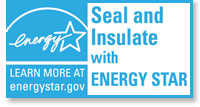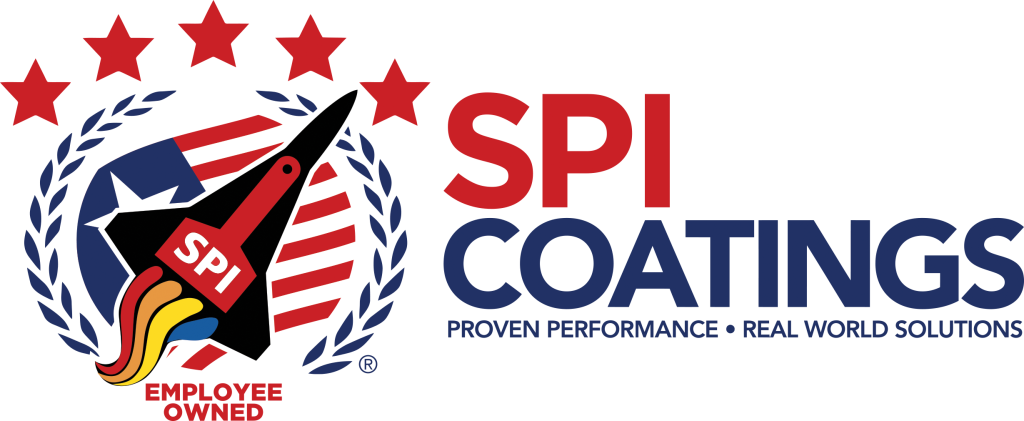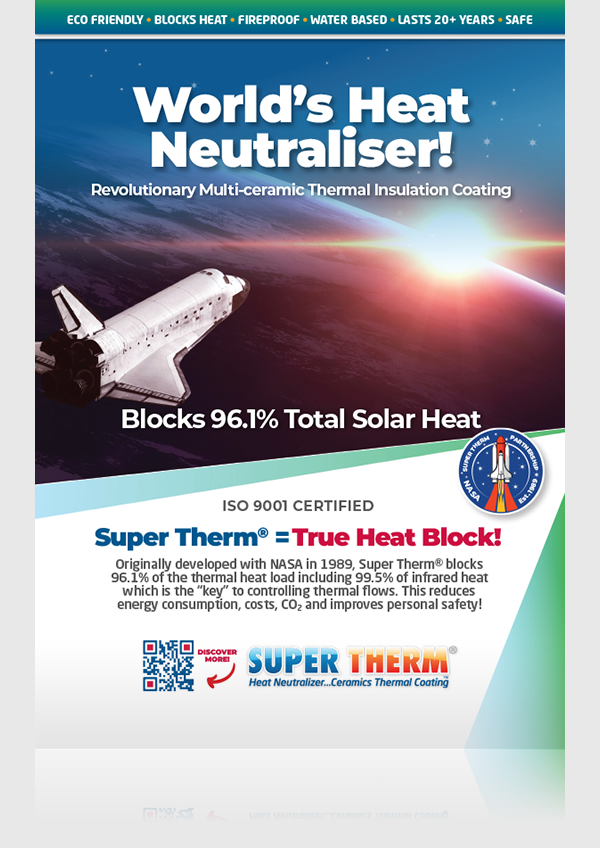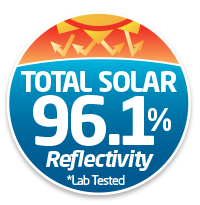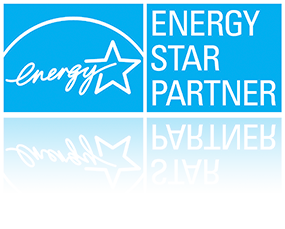Super Therm® Eco Friendly LEED Program
Eco-Friendly Solutions
Although this information below is part of the accreditation systems in the U.S.A. it goes to represent the international high standards and recognition of Super Therm® in leading environmental friendly and energy efficient certifications.
Super Therm® LEED Certifications – pdf
U.S.A. Green Building Council
LEED PROGRAM (Leadership in Environmental and Energy Design)
Green Building Rating System
Points offered for the use of Super Therm® in each of the following categories:
- Super Therm® qualification for LEED points as set forward by the LEED program is as follows:
- Super Therm® is compliant with the “LEED-NC and LEED-EB, Green Building Rating System for New Construction and Existing Construction and Major Renovation” Version 2.2, Sustainable Sites
- Credit 7.1 Heat Island Effect: Non Roof and 7.2 Heat Island Effect: Roof. Coatings under VOC of 250 grams/litre for pitched and flat roofing. Under architectural interior wall paint (1 point) as well as roofing (1 point). Super Therm® is 67 grams/litre.
- Super Therm® falls under the criteria of meeting the test requirements of ASTM E 903 reflectance and ASTM C 1371 emittance. SRI (Solar Reflectance Index) required minimum percentage of 0.75 (Super Therm® – 0.85 which far exceeds the LEED requirement).
- Super Therm® passes and easily complies with the LEED standards for achieving energy points. There is no assigned number to products. The customer applies for points when building a new construction or dong major renovations under version 2.2. The line of SPI Coating Products will add points to the building owner in achieving the highest point system under LEED.
Cool Roofing: LEED and Metal Roofing – USA
by Kevin Corcoran
Products and coatings can help buildings meet program requirements
Metal roofs have long been popular with architects for their dramatic appearance and long-term performance characteristics, particularly their low maintenance costs and durability. With the concept of sustainability now being widely embraced by the architectural community, metal roofs are being seen in a new light. Metal roofing can contribute significantly to the sustainable building movement. Their high recycled content, total recyclability and energy efficiency allow “cool metal roofs” to qualify for points in the Energy Star and Leadership in Energy and Environmental Design (LEED) Green Building Rating System programs.
Used as a guide toward environmental design, LEED uses a credit or point system to establish an overall building performance. Rating points are given for various sustainable features in five categories: building site; water efficiency; energy and atmosphere; materials and resources; and indoor environmental quality. Ratings are based on the number of points earned. For new construction, a building needs at least 52 points out of a total of 69 to reach the platinum level (the highest rating). In descending order, the other levels include gold (39 to 51 points), silver (33 to 38 points) and certified (26 to 32 points).
The LEED program can result in economic and social incentives to building environmentally sound buildings, and metal roofing may offer a path to earning those incentives.
Cool Roof Savings
Cool roofs can reduce heat transfer to the indoor environment, thereby lowering air conditioning costs. Studies monitoring buildings in California and Florida demonstrate that cool roofs save residents and building owners 20 to 70% in annual cooling energy use, and cool metal roofing can qualify for tax incentives and earn LEED credits.
According to LEED, Credit 7.2 is designed to “reduce heat islands (thermal gradient differences between developed and undeveloped areas) to minimize impact on microclimate and human and wildlife habitat.” The credit is worth one point.
The temperatures in the air above heat islands can be as much as 5°c hotter than the surrounding suburbs, leading to higher air conditioning costs, greater use of electricity and higher levels of smog and ozone.
Florida Energy Office research has shown that one additional percent of reflectivity in a roof coating on average will reduce the roof temperature by one degree. The ultimate result is that heat is reflected away from buildings, smog is reduced, energy costs are lowered and the life expectancy of the roof will be increased due to less expansion and contraction.
Cool roofs reflect heat well across the entire solar spectrum, especially in the infrared and visible wavelengths. In addition to absorbing less heat, the coolest roofing materials radiate away any absorbed heat.
Regardless of the kind of material used, cool roofs have two important surface properties: a high solar reflectance and a high thermal emittance. Solar reflectance, also called albedo, is a measure of the ability of a surface material to reflect sunlight — including the visible, infrared, and ultraviolet wavelengths — on a scale of 0 to 1, which can be expressed as a decimal fraction (0.7) or a percentage (70%). Essentially, it is the percentage of solar energy that is reflected by a surface.
Thermal emittance is defined as the percentage of energy a material can radiate away after it is absorbed. It is the ability to release absorbed heat. Scientists use a number between 0 and 1 (or a percentage) to express emittance.
Solar reflectance and thermal emittance have noticeable effects on temperature. Some conventional roof surfaces have low reflectance (from 5 to 25%) and high thermal emittance (typically over 80%). These surfaces can heat up to 65 to 87°c at midday during the summer. Bare metal or metallic surfaced roofs often have a high solar reflectance (typically 50% or higher) and may have low thermal emittance (anywhere between 2% to 66%), depending on their surface treatment. These surfaces warm to 60 to 76°c. Cool roofs with both high reflectance and high emittance warm to only 37 to 48°c in the summer sun.
Energy Star Program
The Environmental Protection Agency’s Energy Star Roof Product Program (www.energystar.gov) has cool roofing specifications for both low-sloped and sloped roofs. Low-sloped roofs (those below 2:12) and flat roofs must have an average initial albedo of at least 0.65, and steep sloped roofs must have an average initial albedo of 0.25 or more.
Under new LEED Version 2.2 requirements approved Oct. 31, 2005, roofing materials used on low slope roofs with a slope of less than 2:12 must now meet a solar reflectance index (SRI) of 78, while steep-sloped roofs with a slope of more than 2:12 must have an SRI of 29.
According to these new requirements, an SRI is defined as “a measure of the constructed surface’s ability to reflect solar heat as shown by a small temperature rise. It is defined so that a standard black with reflectance of 0.05 and emittance of 0.90 is zero (0) while the SRI for a standard white (reflectance of 0.80 and emittance 0.90) is 100.”
To calculate the SRI for a given material, it is necessary to obtain the reflectance and emittance values for the material. SRI is calculated according to ASTM E 1980. This is a standard practice for calculating the solar reflectance index of horizontal and low-sloped opaque surfaces with emissivity greater than 0.1. Reflectance is calculated according to any one of three ASTM standards — ASTM E 903, ASTM E 1918 or ASTM C 1549. Emittance is calculated according to ASTM E 408 or ASTM C 1371.
Cool Colors
Tests have shown that on a 32°c day, a white roof will only have a temperature of 43°c at its surface while a black roof will have a reading of 87°c. However, it would be a very dull country if architects and builders could not enhance the appearance of their products and were restricted to white, despite the energy savings. Consequently, roof coatings manufacturers have been developing cool roof coatings that increase heat reflectivity and reduce emissivity without sacrificing colour choices.
New infrared-reflective pigments incorporated into paints used on architectural metal roofing products allow them to achieve higher reflectivity values, even in darker colours such as black and brown. This improved reflectivity — the reflectivity for black, for example, changes from 0.07 with normal pigments to 0.32 with infrared-reflective pigments — can mean a much cooler surface temperature and greater energy savings for the building below. This allows facility executives to select a sustainable roof without having to sacrifice aesthetics.
Research shows that most of the cool roof coatings and colours available today have little or no trouble meeting the reflectivity standards for the LEED and Energy Star programs. Some, however, would fall short in meeting emissivity requirements if the entire roof surface required it.
However, utilizing the weighted average calculation as defined by LEED in one of its recent Credit Interpretation Rulings (CIR), only 75% of the roof surface must have 0.90 emissivity; the remaining 25% can be anything. There are many LEED Credit Interpretations Rulings that have allowed a lower emissivity or solar reflectance — but not both — where 100% of the roof surface is covered by one material, including a painted metal.
This means any prepainted metal covering 100% of the roof, meeting the Energy Star Solar Reflectance specification, and having a thermal emittance of 0.70 or greater, meets or exceeds the LEED 7.2 credit criteria.
These Credit Interpretation Request (CIR) rulings can be critical when planning a LEED-compliant building. They are available from the U.S. Green Building Council in a catalog of questions formally asked of the Council by registered LEED projects. CIR rulings, once published, apply to all subsequent projects, and provide important guidance not found in the LEED reference manual.
Energy Performance
Most industry experts agree that reflectivity has a greater impact than emissivity on the energy performance of the roof during hot weather. If a majority of the initial solar radiation is reflected, then a smaller portion is left for infrared emittance. Many cool roofs have reflectivities of 75 to 80%, which means that only 20 to 25% of the sun’s energy is absorbed into the roof.
According to the Lawrence Berkeley National Laboratory, at an ambient temperature of 98 degrees, a change in a roof’s emissivity from 0.75 to 0.90 while keeping reflectivity constant results in a surface temperature reduction of two degrees. Conversely, raising a roof’s reflectivity from 0.25 to 0.40 while keeping emissivity constant results in a surface temperature reduction of 13°, a substantial difference.
Still, the combination of high reflectivity and high emissivity during hot summer months results in a surface temperature sometimes as much as 60 to 70° cooler than a non-reflective roof. The reduction in heat energy means less need for air conditioning and lower energy costs.
Product Compliance
How do roof and roof coatings manufacturers gain LEED compliancy? It must be made clear that the U.S. Green Building Council does not certify products, but only buildings, in the LEED program. However, products and their manufacturers can meet standards to become designated as compliant with Energy Star or LEED programs. For example, a product might verify claims that it can contribute to earning LEED points in a particular category.
In the case of Energy Star and LEED, a qualified laboratory can determine the solar reflectance required by the program. The laboratory does not need to be independent of the material manufacturer; therefore both third party and manufacturer laboratories can be used to provide data to the EPA.
However, the Cool Roof Rating Council (CRRC), an independent, nonprofit industry association, requires that the laboratory conducting the measurement be accredited. Either the lab must be listed as an Accredited Independent Testing Laboratory (AITL) by the CRRC or it must be an Accredited Manufacturers Testing Laboratory (AMTL) to perform the tests to determine reflectivity and emissivity. Both the AITL and the AMTL must meet the requirements of the CRRC, which includes ISO certification of the lab, as well as additional required CRRC training.
Kevin Corcoran is the vice president of business development at Englert and a 27-year veteran of the metal roofing industry. April 12, 2006 (source)



